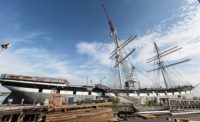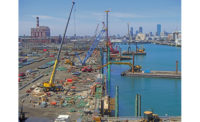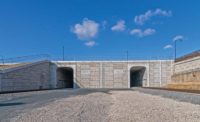ENR 2023 New England Best Projects
Best Project Specialty Construction: Historic Stone Bridge Remediation of CSX Acquired Pan Am Railway

Photo courtesy GeoStabilization International
Historic Stone Bridge Remediation of CSX-Acquired Pan Am Railway
Lancaster, Mass.
BEST PROJECT
Submitted by: GeoStabilization International
Owner: CSX Transportation
Lead Design Firm/General Contractor: GeoStabilization International
When CSX acquired the Pan Am Railway in 2022, inspections revealed several issues with the existing track and infrastructure. Many of these structures required maintenance or repairs and faced issues such as foundation scour, bridge seat deterioration, stone mortar deterioration and voids within stone piers. Many bridges and retaining walls along the Pan Am network date back to the late 1800s and early 1900s, mainly using large granite stacked stone block construction.
At more than 1 ton each, the blocks originally had little to no mortar between them, and later efforts to tuckpoint or patch the original mortar found it was heavily deteriorated or completely gone by 2022. Three stone bridges on the line—Bridge 69.96 in Augusta, Maine; Bridge 7.12 in Westford, Mass.; and Bridge 19.05 in Lancaster, Mass.—all had different structural and maintenance problems with their foundations that had to be addressed and completed within the project’s six-month schedule. After site visits to all three locations, the team developed and began repair plans for the first site in mid-July.

Photo courtesy GeoStabilization International
Bridge 69.96 had significant scour issues at the base of its north abutment because the timber piles that supported the stacked stone foundations had degraded. The solution involved sheet pile encapsulation of the footing into the embankment, backfill grout and structural concrete to fill the void space within the timber piles and between the sheet piles and the stone footings. Both abutments were cleared of vegetation and all the stone joints were tuckpointed and sealed with mortar. Steel through rods were added to tie the exposed sheet pile sections together and to add rigidity to the structure, while the sheet piles were left in place to serve both as formwork for the backfill concrete and additional protection against future scour. Different issues affected the other two bridges, with Bridge 7.12 having a deteriorated bridge seat that required anchor and shotcrete repair. Bridge 19.05 had a stone pier with a void that required high-strength grout void fill. The repair plans for these bridges came together as construction progressed across the project’s various locations.
With these repair solutions, the team was able to restore historically significant structures with modern technologies and materials while still maintaining the bridges’ original appearance and character.
Challenges across all three bridge sites included securing access to the site, dealing with compromised stone footings and ensuring that vibrations from installing the sheet piles did not cause further damage. The project improved the client’s infrastructure to accommodate increased traffic and train speeds.

Photo courtesy GeoStabilization International
The $1.1-million, six-month project was finished at budget and on schedule in December 2022.
Comprehensive safety training was conducted regularly, ensuring that workers were up to date with the latest safety protocols. A robust hazard assessment and mitigation process was established to identify potential risks and implement appropriate controls. Regular safety inspections were conducted to monitor compliance with safety protocols and identify any hazards or unsafe conditions. The project had no OSHA recordable incidents or lost-time accidents during 2,165 work hours.



